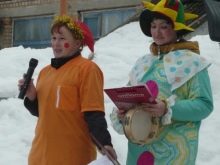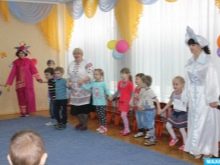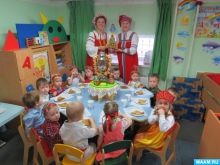Shrovetide games for children
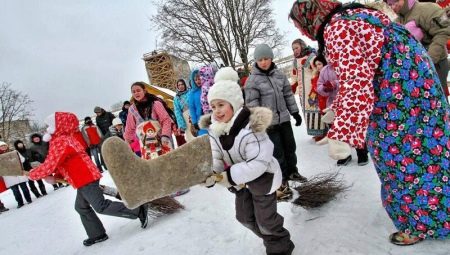
Play in a child's life has a special meaning. This is not only an interesting pastime, but also the development of thinking, coordination of movements. And if you introduce the game to a certain holiday, then this is also another way to get better acquainted with the world around you. Properly planned Shrovetide games will not only entertain children, but also introduce them to the customs and rituals of our ancestors - the ancient Slavs.
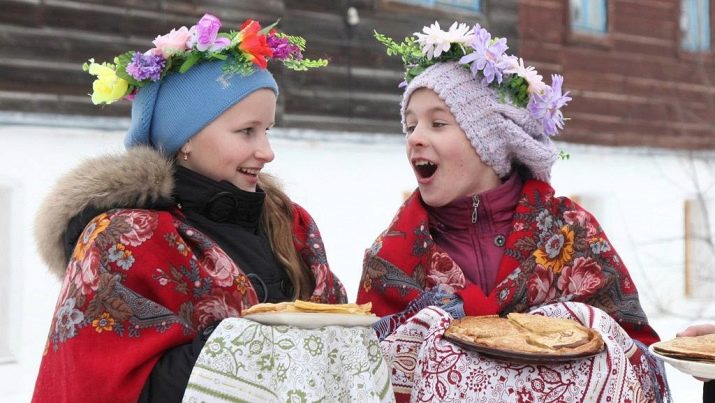
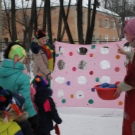
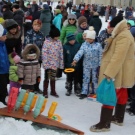
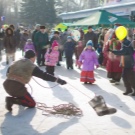
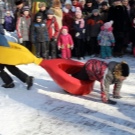
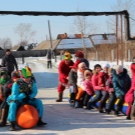
Street games
Traditional Shrovetide round dances and competitions (tug of war, fistfight) can be diversified, taking into account the age of children, with various other games and competitions, which can be organized both outdoors and indoors. Such events are important because they have both cultural, educational and developmental significance.
On the street on Maslenitsa for children, it is best to select outdoor games with the massive participation of all children. And if Shrovetide week turned out to be cold, then no one should stand at all. To make children's games fun, prepare in advance various chants that cheer up and give a sense of excitement to the competing children.
In this case, you should not count on music, since the sound scatters on the street, and the shouts of the guys drown it out.
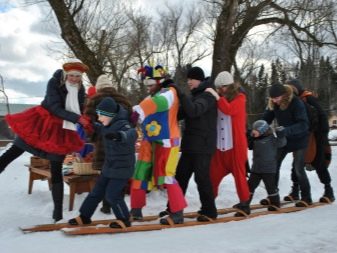

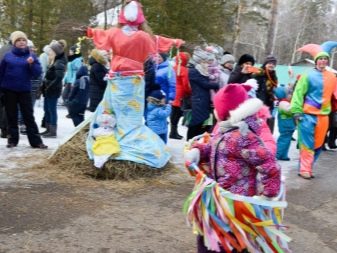
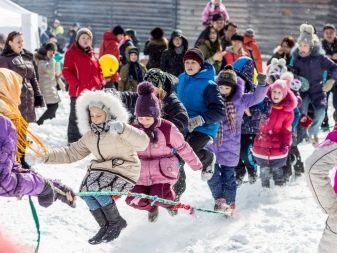
"Kostroma"
Children stand in a circle, holding hands, and slowly lead a round dance. The presenter, playing the role of Kostroma, stands in the center of the round dance. There is a musical dialogue between the children (everyone is singing):
- “Kostroma, Kostroma, my lady!
- Kostroma has jelly with pie,
- Kostroma has a pie with cottage cheese! "
- Are you healthy, Kostroma? "
- Kostroma: "She was healthy!"
- Children: "Where have you been, Kostroma?"
- Kostroma: "On the river yesterday!"
- Children: "What did you see, Kostroma?"
- Kostroma: "Gray duck!"
- Children: "What are you doing now?"
- Kostroma: "Now I will catch you all!"
At the last words of Kostroma, the children, letting go of each other's hands, scatter, and Kostroma catches up with them.
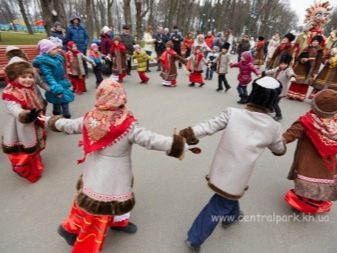
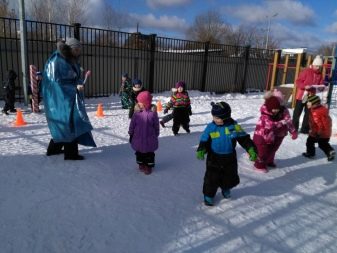
Carousel game
Ribbons are tied to the pole, which should be 1 less than the number of children. Music is playing (in younger groups it will be better if the children sing instead of music, since singing contributes to the development of the articulatory apparatus), the pole spins. As soon as the music turns off, children should grab the tape. Those who do not have time are eliminated. This continues until 1 person remains.
Instead of a pole, you can use a hoop, to which ribbons are also tied.
A disguised person becomes the center of the hoop and, if necessary, holds it or twists it. Among other things, ribbons can be tied to the belt of a person playing a role, for example, of spring. The man spinning the carousel speaks the words:
- Somehow, barely
- The carousel is spinning
- But then later
- The best is to run.
- But first, take your time
- Stop our carousel.
- One two Three,
- Carousel, freeze.
It is permissible to conduct the game both in the hall and on the street.
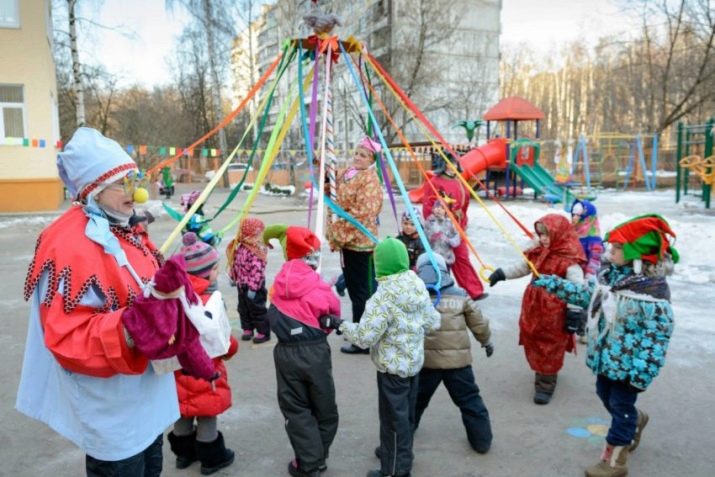
"Burners"
Children become pairs one after another and, holding hands, raise their hands up (as for playing "Stream"). The last pair, also holding hands, passes between the guys through the entire column and becomes the first, and all other pairs do the same. As soon as everyone passes through the so-called corridor, everyone, still standing in pairs, sings the song "Burn, burn clearly":
Burn, burn, clear
So as not to go out!
Look at the sky,
The birds are flying
The bells are ringing:
Ding-dong, ding-dong,
Run out quickly!
On the last lines of the song, the first pair, scattering to the sides, goes to the end of the column, and the leader (he may be an adult or a child who did not get a pair) is trying to catch someone from the first pair. If the children managed to reach the end of the column, then they again become a couple. If they managed to catch one of them, then he becomes the leader, and the remaining child and the one who caught them close the column.
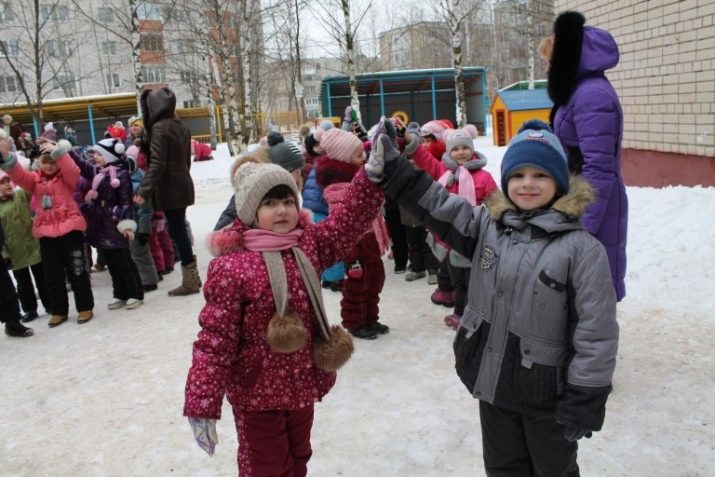
"Catch-up" or "Trap"
You can play with the guys at Shrovetide and the familiar "Catch-up" or "Trap", just to maintain a festive mood in the game you need to bring some novelty. You can, for example, dress up the presenter.
In order for children to get acquainted with the culture of the ancient Slavs, it is recommended for the presenter to use such characters as a goat-goat (among our ancestors they were considered a symbol of fertility), Spring, Maslenitsa.
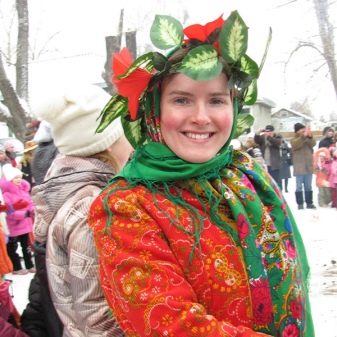
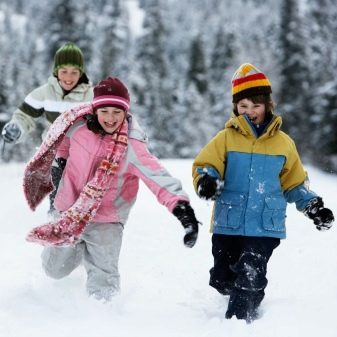
Game "Frying pans"
A circle is drawn on the snow, the size of which depends on the number of children (the more children, the larger the circle). This circle is considered an imitation of a hot frying pan. On the count of 3, the guys standing near the circle jump on 1 leg, trying to push their neighbor into the circle. Whoever got there was fried.
To avoid crowding, it is recommended to draw a circle, for example, separately for girls and separately for boys.
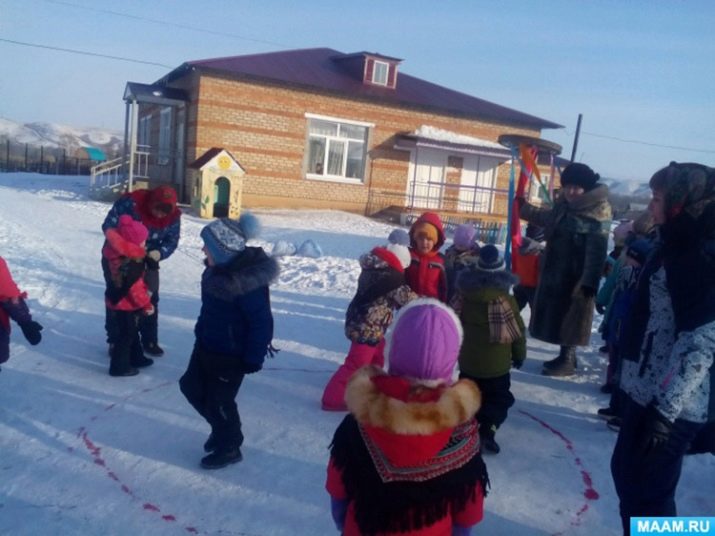
In addition to games, Maslenitsa is not complete without contests.
- Competition "Fight on the bench". In the old days, not a single Maslenitsa could do without Maslenitsa fist fights. A similar competition, having thought over safety measures taking into account the age of the children, can be held in kindergarten. It can be a fight on a bench with pillows (for the older groups), for the younger you can use a fight on a bench using balloons in the form of sticks or cardboard swords. The task of the competitors is to fight until the opponent falls off the bench.
- Competition "Who is Bigger?" Since Shrovetide is not only eating pancakes, but also meeting spring, it is possible to hold competitions for speed and agility by adding festive paraphernalia to the game. It is allowed to hold a competition "Who is more?" as an independent, or you can include it in the relay. Children are divided into teams, the task of which is to collect as many artificial snowdrops or, for example, paper pancakes, scattered across the field (hall, playground).

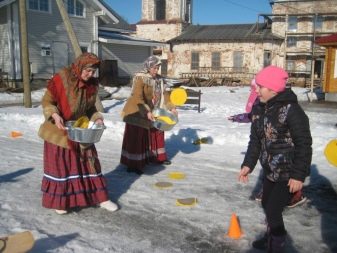
Indoor contests
It is allowed to hold the above games and competitions in the premises: "Who is more?", "Fight on the bench", "Carousel". But besides them, there are many more interesting tasks recommended directly for carrying out in a music hall or other room intended for a holiday.
- "Damn golden." Children stand in a circle (there is no need to hold hands), music is playing. Meanwhile, a symbol of Shrovetide is being passed from hand to hand. It can be a cardboard pancake, a toy sun, or a doll dressed up for Spring or Shrovetide. As soon as the music stops, the child, in whose hands the attribute remains, goes into a circle and begins to dance. Then the music continues, the child falls into place, and the game continues.
- "Fixed blind man's buffs". A driver is chosen, who is blindfolded and twisted in place several times, then in one direction, then in the other. The rest of the guys run around the hall and freeze in place. Then the driver, blindfolded, walks around the hall and tries to tarnish all the guys. The one who is stained last wins.
- During Shrovetide gatherings, you can play the game "Tambourine". Sitting at the table, the children pass a tambourine to each other to the accompaniment of music. As soon as the music stops playing, the child, in whose hands the tambourine was found, leaves the table and amuses the others (dances, sings a song).
- "Chicken on a perch". This game is a kind of massive competition. To carry it out, you will need many wide, thick-bound books (you can borrow it from the library). Books are arranged around the hall in a checkerboard pattern in small piles (3-4). The players come up to the pile and try to jump onto it at the count of 3. The one who succeeds wins.
When there are fewer players left, the task can be made more difficult by making the stack of books taller. The game is a parody of the "Climb a high pillar" competition.
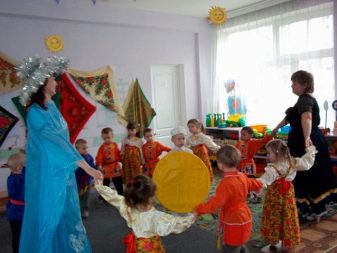
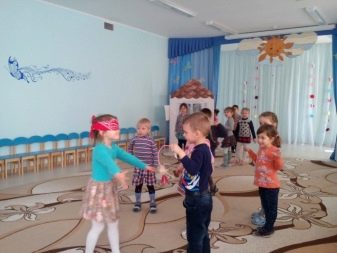
Round dance fun
No Shrovetide festivities take place without the traditional Russian folk round dance. This fun is aimed not only at improving the coordination of movements, but also contributes to the development of musical ear.
If during the round dance the kids sing along, then, among other things, the articulatory apparatus develops.
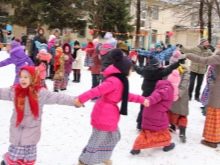
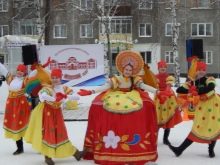
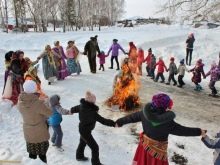
"Round dance with a scarf"
Children join hands and begin to dance, and in the center of the circle stands Maslenitsa (a mummed adult) and sings:
- I'm Shrovetide, Shrovetide, but not a stepdaughter,
- As soon as I go with a handkerchief, I will come to you right now!
- A handkerchief lies on the shoulders, who comes running first,
- He takes a handkerchief from me and will invite us to spring!
- The children sing along to her:
- Come spring, come red! There will be no time for sleep for all of us!
- Be happy to come soon! Give us all the sun!
On the last lines, the round dance stops, and Maslenitsa points at its discretion to 2 guys who enter the circle and turn their backs to each other. On the count of 3, the guys run in opposite directions. The winner is the one who is the first to reach Maslenitsa and take a handkerchief from her.

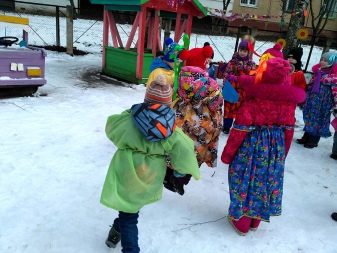
"How much are pancakes?"
This is a musical dramatization. Children should carefully listen to the leader and repeat all the actions after him (in the younger group, movements can be learned in advance):
- we make a fire in the stove - the guys, standing in a circle, stomp loudly, depicting the crackle of burning firewood;
- you need to heat the frying pan - the guys, holding hands, dance;
- we take jam - a song is playing where berries are mentioned (for example, "Ah, my raspberry, my raspberry"), the children are dancing;
- we spread the pancakes with jam and fold them - the children show a lump in any form (this can be a narrowing of the round dance to the center);
- the pancakes turned out to be glorious - the children diverge in different directions, depicting a round pancake.


Fun "Skomorokhi"
Suitable for younger preschoolers. Children put on joker hats with bells and perform various tasks. It can be dance moves or animal parody.
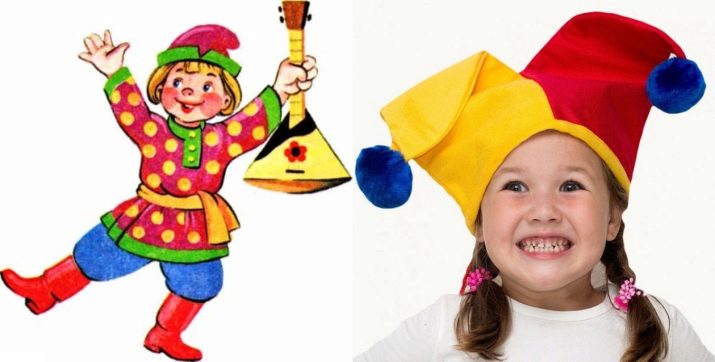
Program for the little ones
We present to your attention a competition program for the celebration of Maslenitsa for the little ones (nursery group), which can be held both in the music hall and in the play area of the kindergarten group.
Children, if possible, are dressed up (since not all children from 1.5 to 3 years old agree to change clothes, a headband with an image of a character is quite enough) and sit on chairs.
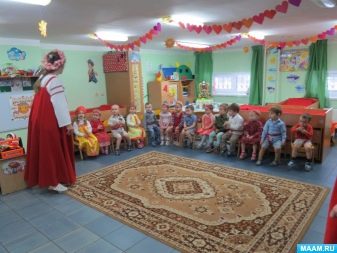

Skomorokhs (adults) appear: Vanka and Petrushka.
- Vanka: Hello, boys!
- Petrushka: Hello girls!
- Skomorokhs together: And we wish the adults health!
- Children with adults: Hello!
- Parsley: I am Parsley-jolly!
- Roly! I am Vanka-vstanka!
- Buffoons together: And we came to amuse you, celebrate Maslenitsa, spend the winter and meet the spring!
- Winter appears to the frightening music. Winter: Well, well, well! Who wants to chase me away? Who is tired of my snowballs and sledding?
- Buffoons in unison: No! No! No! Mother Winter, of course, we are not tired of your amusements, but after all, it's time for you to rest. It's time for birds and animals to meet the spring sun!
- Winter: If you are waiting for warm days, if you want the sun, then entertain me! The Snowman is calling: "Hey, Snowman, my faithful friend, come here soon, let's play more fun!" A Snowman appears, rolls a cart, in which there are many snowballs made of cotton wool or white paper.
- Snowman: Here I am, Mother Winter, let's play, kids?
- Children: YEAAA!
- Snowman: Come on, kids, I have a snowy mountain here! You take snowballs in your hands and fill us with winter with snow.
- Children, under the guidance of buffoons and educators, throw snow at Snowman and Winter. The game ends when there is no snow left in the cart.
- Winter: Oh, I'm a little tired! I should sit and rest and still look at you!
- Educator: Of course, Winter is winter, sit by our yard (they invite her to sit on a chair), show you how they can dance.
- Children with the help of the characters mentioned above stand around Winter in a circle and hold hands. Educators, children lead a round dance to cheerful music and say: “Winter is winter! Where have you been? "
- Winter: I brought cold to you and shook it to the ground! (Children rub themselves with pens, pretending to be cold.)
- Educators, children: Oh you, Winter-winter, you won't freeze me. I will run and dance and amuse you.
- At first, as far as possible, they quickly run in a circle, and then slowly narrow the circle towards Winter. Then, having disconnected their hands, they run away, Winter catches up with them.
- Winter: Oh, you kids, kids, you tired me. It can be seen, however, you need to rest, clearing the way for others.
- Snowman: Somehow it started to get warm here, we clean up, kids, snow, and we'll go to rest, and it's time for you to meet Spring.
- Children, with the help of educators and buffoons, throw snow into the cart. Winter is leaving. Spring appears.
- Spring: Hello guys. Oh, and for a long time I waited for the bright sun to warm up. But that's bad luck: the rays of the sun are too small. The teacher places a poster with a sun without rays on the board.
- Buffoons: Hello, Mother Spring, this is not a problem at all. The guys and I will now fix everything in a moment.
- Dips a brush in yellow paint and draws a beam. Adults help children draw rays.
- Spring: Thank you, kids, I feel the warmth of the sun. It's time for me to leave, but I want to treat you to. (Brings and puts on the table a plate of pancakes.) The sun is warm, it gives everyone goodness.
- Skomorokh Petrushka: Well, it's time for us, friends, to run away from the yard.
- Buffoon Vanka: Well, you wash your hands and sit down, have a good meal.
